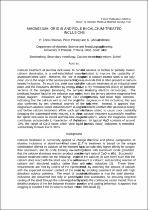JavaScript is disabled for your browser. Some features of this site may not work without it.
- ResearchSpace
- →
- Research Publications/Outputs
- →
- Conference Publications
- →
- View Item
| dc.contributor.author |
Pistorius, PC

|
|
| dc.contributor.author |
Presoly, P

|
|
| dc.contributor.author |
Tshilombo, G

|
|
| dc.date.accessioned | 2010-08-15T12:56:50Z | |
| dc.date.available | 2010-08-15T12:56:50Z | |
| dc.date.issued | 2009-08 | |
| dc.identifier.citation | Pistorius, PC, Presoly, P, and Tshilombo, G. 2009. Magnesium: origin and role in calcium-treated inclusions. SOHN International Symposium, Advanced Processing of Metals and Materials: Principles, Technologies and Industrial Practice, Catamaran Resort San Diego, California, USA, pp 373-378 | en |
| dc.identifier.isbn | 9780873396332 | |
| dc.identifier.uri | http://hdl.handle.net/10204/4146 | |
| dc.description | SOHN International Symposium, Advanced Processing of Metals and Materials: Principles, Technologies and Industrial Practice, Catamaran Resort San Diego, California, USA | en |
| dc.description.abstract | Steel was sampled after calcium treatment at an industrial steel plant, and the inclusions identified by energy-dispersive X-ray microanalysis (EDX) on polished sections of the samples analysing the samples in a scanning electron microscope. The predicted fraction liquid in the inclusion was estimated from the ternary alumina-magnesia-lime phase diagram. Inclusions with higher CaO contents generally had lower MgO contents, indicating that the calcium wire is not the origin of the magnesium in the inclusions; this was also confirmed by wet chemical analysis of the calcium wire. Instead, it appears that magnesium-alumina spinel inclusions form during extended ladle contact after aluminium killing and before calcium treatment. While such spinels have been stated to cause poor castability clogging the submerged-entry nozzle, it is clear that calcium treatment successfully modifies the spinel inclusions to mixed alumina-lime-magnesia inclusions, where the magnesia content contributes substantially to liquefaction of the inclusions: for typical MgO contents of around 10%, the range of Ca:O ratios which yield liquid or partially liquid inclusions is extended substantially to lower Ca:O ratios. | en |
| dc.language.iso | en | en |
| dc.subject | Steel making | en |
| dc.subject | Metallurgy | en |
| dc.subject | Calcium treatment | en |
| dc.subject | Magnesium | en |
| dc.subject | Spinel | en |
| dc.subject | Microanalysis | en |
| dc.subject | Calcium wire | en |
| dc.subject | Aluminium | en |
| dc.subject | Metals | en |
| dc.title | Magnesium: origin and role in calcium-treated inclusions | en |
| dc.type | Conference Presentation | en |
| dc.identifier.apacitation | Pistorius, P., Presoly, P., & Tshilombo, G. (2009). Magnesium: origin and role in calcium-treated inclusions. http://hdl.handle.net/10204/4146 | en_ZA |
| dc.identifier.chicagocitation | Pistorius, PC, P Presoly, and G Tshilombo. "Magnesium: origin and role in calcium-treated inclusions." (2009): http://hdl.handle.net/10204/4146 | en_ZA |
| dc.identifier.vancouvercitation | Pistorius P, Presoly P, Tshilombo G, Magnesium: origin and role in calcium-treated inclusions; 2009. http://hdl.handle.net/10204/4146 . | en_ZA |
| dc.identifier.ris | TY - Conference Presentation AU - Pistorius, PC AU - Presoly, P AU - Tshilombo, G AB - Steel was sampled after calcium treatment at an industrial steel plant, and the inclusions identified by energy-dispersive X-ray microanalysis (EDX) on polished sections of the samples analysing the samples in a scanning electron microscope. The predicted fraction liquid in the inclusion was estimated from the ternary alumina-magnesia-lime phase diagram. Inclusions with higher CaO contents generally had lower MgO contents, indicating that the calcium wire is not the origin of the magnesium in the inclusions; this was also confirmed by wet chemical analysis of the calcium wire. Instead, it appears that magnesium-alumina spinel inclusions form during extended ladle contact after aluminium killing and before calcium treatment. While such spinels have been stated to cause poor castability clogging the submerged-entry nozzle, it is clear that calcium treatment successfully modifies the spinel inclusions to mixed alumina-lime-magnesia inclusions, where the magnesia content contributes substantially to liquefaction of the inclusions: for typical MgO contents of around 10%, the range of Ca:O ratios which yield liquid or partially liquid inclusions is extended substantially to lower Ca:O ratios. DA - 2009-08 DB - ResearchSpace DP - CSIR KW - Steel making KW - Metallurgy KW - Calcium treatment KW - Magnesium KW - Spinel KW - Microanalysis KW - Calcium wire KW - Aluminium KW - Metals LK - https://researchspace.csir.co.za PY - 2009 SM - 9780873396332 T1 - Magnesium: origin and role in calcium-treated inclusions TI - Magnesium: origin and role in calcium-treated inclusions UR - http://hdl.handle.net/10204/4146 ER - | en_ZA |






